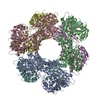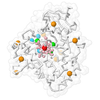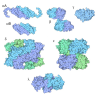[English] 日本語
 Yorodumi
Yorodumi- EMDB-46854: The Cryo-EM structure of recombinantly expressed hUGDH in complex... -
+ Open data
Open data
- Basic information
Basic information
| Entry |  | |||||||||
|---|---|---|---|---|---|---|---|---|---|---|
| Title | The Cryo-EM structure of recombinantly expressed hUGDH in complex with UDP-4-keto-xylose | |||||||||
 Map data Map data | Full map | |||||||||
 Sample Sample |
| |||||||||
 Keywords Keywords | Human UDP-Glucose Dehydrogenase / UDP-4-keto-xylose / OXIDOREDUCTASE / OXIDOREDUCTASE-INHIBITOR complex | |||||||||
| Function / homology |  Function and homology information Function and homology informationFormation of the active cofactor, UDP-glucuronate / UDP-glucose 6-dehydrogenase activity / UDP-glucose 6-dehydrogenase / UDP-glucuronate biosynthetic process / glycosaminoglycan biosynthetic process / chondroitin sulfate proteoglycan biosynthetic process / heparan sulfate proteoglycan biosynthetic process / gastrulation with mouth forming second / protein hexamerization / neuron development ...Formation of the active cofactor, UDP-glucuronate / UDP-glucose 6-dehydrogenase activity / UDP-glucose 6-dehydrogenase / UDP-glucuronate biosynthetic process / glycosaminoglycan biosynthetic process / chondroitin sulfate proteoglycan biosynthetic process / heparan sulfate proteoglycan biosynthetic process / gastrulation with mouth forming second / protein hexamerization / neuron development / NAD binding / extracellular exosome / nucleoplasm / identical protein binding / nucleus / cytosol Similarity search - Function | |||||||||
| Biological species |  Homo sapiens (human) Homo sapiens (human) | |||||||||
| Method | single particle reconstruction / cryo EM / Resolution: 2.38 Å | |||||||||
 Authors Authors | Kadirvelraj R / Walsh Jr RM / Wood ZW | |||||||||
| Funding support |  United States, 1 items United States, 1 items
| |||||||||
 Citation Citation | Journal: Acta Crystallogr D Struct Biol / Year: 2019 Title: Macromolecular structure determination using X-rays, neutrons and electrons: recent developments in Phenix. Authors: Dorothee Liebschner / Pavel V Afonine / Matthew L Baker / Gábor Bunkóczi / Vincent B Chen / Tristan I Croll / Bradley Hintze / Li Wei Hung / Swati Jain / Airlie J McCoy / Nigel W Moriarty ...Authors: Dorothee Liebschner / Pavel V Afonine / Matthew L Baker / Gábor Bunkóczi / Vincent B Chen / Tristan I Croll / Bradley Hintze / Li Wei Hung / Swati Jain / Airlie J McCoy / Nigel W Moriarty / Robert D Oeffner / Billy K Poon / Michael G Prisant / Randy J Read / Jane S Richardson / David C Richardson / Massimo D Sammito / Oleg V Sobolev / Duncan H Stockwell / Thomas C Terwilliger / Alexandre G Urzhumtsev / Lizbeth L Videau / Christopher J Williams / Paul D Adams /    Abstract: Diffraction (X-ray, neutron and electron) and electron cryo-microscopy are powerful methods to determine three-dimensional macromolecular structures, which are required to understand biological ...Diffraction (X-ray, neutron and electron) and electron cryo-microscopy are powerful methods to determine three-dimensional macromolecular structures, which are required to understand biological processes and to develop new therapeutics against diseases. The overall structure-solution workflow is similar for these techniques, but nuances exist because the properties of the reduced experimental data are different. Software tools for structure determination should therefore be tailored for each method. Phenix is a comprehensive software package for macromolecular structure determination that handles data from any of these techniques. Tasks performed with Phenix include data-quality assessment, map improvement, model building, the validation/rebuilding/refinement cycle and deposition. Each tool caters to the type of experimental data. The design of Phenix emphasizes the automation of procedures, where possible, to minimize repetitive and time-consuming manual tasks, while default parameters are chosen to encourage best practice. A graphical user interface provides access to many command-line features of Phenix and streamlines the transition between programs, project tracking and re-running of previous tasks. | |||||||||
| History |
|
- Structure visualization
Structure visualization
| Supplemental images |
|---|
- Downloads & links
Downloads & links
-EMDB archive
| Map data |  emd_46854.map.gz emd_46854.map.gz | 48.4 MB |  EMDB map data format EMDB map data format | |
|---|---|---|---|---|
| Header (meta data) |  emd-46854-v30.xml emd-46854-v30.xml emd-46854.xml emd-46854.xml | 23.5 KB 23.5 KB | Display Display |  EMDB header EMDB header |
| FSC (resolution estimation) |  emd_46854_fsc.xml emd_46854_fsc.xml | 7.8 KB | Display |  FSC data file FSC data file |
| Images |  emd_46854.png emd_46854.png | 87.8 KB | ||
| Filedesc metadata |  emd-46854.cif.gz emd-46854.cif.gz | 7.4 KB | ||
| Others |  emd_46854_half_map_1.map.gz emd_46854_half_map_1.map.gz emd_46854_half_map_2.map.gz emd_46854_half_map_2.map.gz | 47.4 MB 47.4 MB | ||
| Archive directory |  http://ftp.pdbj.org/pub/emdb/structures/EMD-46854 http://ftp.pdbj.org/pub/emdb/structures/EMD-46854 ftp://ftp.pdbj.org/pub/emdb/structures/EMD-46854 ftp://ftp.pdbj.org/pub/emdb/structures/EMD-46854 | HTTPS FTP |
-Validation report
| Summary document |  emd_46854_validation.pdf.gz emd_46854_validation.pdf.gz | 908.4 KB | Display |  EMDB validaton report EMDB validaton report |
|---|---|---|---|---|
| Full document |  emd_46854_full_validation.pdf.gz emd_46854_full_validation.pdf.gz | 908 KB | Display | |
| Data in XML |  emd_46854_validation.xml.gz emd_46854_validation.xml.gz | 15.5 KB | Display | |
| Data in CIF |  emd_46854_validation.cif.gz emd_46854_validation.cif.gz | 19.9 KB | Display | |
| Arichive directory |  https://ftp.pdbj.org/pub/emdb/validation_reports/EMD-46854 https://ftp.pdbj.org/pub/emdb/validation_reports/EMD-46854 ftp://ftp.pdbj.org/pub/emdb/validation_reports/EMD-46854 ftp://ftp.pdbj.org/pub/emdb/validation_reports/EMD-46854 | HTTPS FTP |
-Related structure data
| Related structure data |  9dh0MC  9dgzC M: atomic model generated by this map C: citing same article ( |
|---|---|
| Similar structure data | Similarity search - Function & homology  F&H Search F&H Search |
- Links
Links
| EMDB pages |  EMDB (EBI/PDBe) / EMDB (EBI/PDBe) /  EMDataResource EMDataResource |
|---|---|
| Related items in Molecule of the Month |
- Map
Map
| File |  Download / File: emd_46854.map.gz / Format: CCP4 / Size: 51.4 MB / Type: IMAGE STORED AS FLOATING POINT NUMBER (4 BYTES) Download / File: emd_46854.map.gz / Format: CCP4 / Size: 51.4 MB / Type: IMAGE STORED AS FLOATING POINT NUMBER (4 BYTES) | ||||||||||||||||||||||||||||||||||||
|---|---|---|---|---|---|---|---|---|---|---|---|---|---|---|---|---|---|---|---|---|---|---|---|---|---|---|---|---|---|---|---|---|---|---|---|---|---|
| Annotation | Full map | ||||||||||||||||||||||||||||||||||||
| Projections & slices | Image control
Images are generated by Spider. | ||||||||||||||||||||||||||||||||||||
| Voxel size | X=Y=Z: 0.825 Å | ||||||||||||||||||||||||||||||||||||
| Density |
| ||||||||||||||||||||||||||||||||||||
| Symmetry | Space group: 1 | ||||||||||||||||||||||||||||||||||||
| Details | EMDB XML:
|
-Supplemental data
-Half map: Half map2
| File | emd_46854_half_map_1.map | ||||||||||||
|---|---|---|---|---|---|---|---|---|---|---|---|---|---|
| Annotation | Half map2 | ||||||||||||
| Projections & Slices |
| ||||||||||||
| Density Histograms |
-Half map: Half map1
| File | emd_46854_half_map_2.map | ||||||||||||
|---|---|---|---|---|---|---|---|---|---|---|---|---|---|
| Annotation | Half map1 | ||||||||||||
| Projections & Slices |
| ||||||||||||
| Density Histograms |
- Sample components
Sample components
-Entire : Human UDP-Glucose Dehydrogenase in complex with UDP-4-keto-xylose
| Entire | Name: Human UDP-Glucose Dehydrogenase in complex with UDP-4-keto-xylose |
|---|---|
| Components |
|
-Supramolecule #1: Human UDP-Glucose Dehydrogenase in complex with UDP-4-keto-xylose
| Supramolecule | Name: Human UDP-Glucose Dehydrogenase in complex with UDP-4-keto-xylose type: complex / ID: 1 / Parent: 0 / Macromolecule list: #1 |
|---|---|
| Source (natural) | Organism:  Homo sapiens (human) Homo sapiens (human) |
| Molecular weight | Theoretical: 55.024 KDa |
-Macromolecule #1: UDP-glucose 6-dehydrogenase
| Macromolecule | Name: UDP-glucose 6-dehydrogenase / type: protein_or_peptide / ID: 1 / Number of copies: 6 / Enantiomer: LEVO / EC number: UDP-glucose 6-dehydrogenase |
|---|---|
| Source (natural) | Organism:  Homo sapiens (human) Homo sapiens (human) |
| Molecular weight | Theoretical: 55.093938 KDa |
| Recombinant expression | Organism:  |
| Sequence | String: MFEIKKICCI GAGYVGGPTC SVIAHMCPEI RVTVVDVNES RINAWNSPTL PIYEPGLKEV VESCRGKNLF FSTNIDDAIK EADLVFISV NTPTKTYGMG KGRAADLKYI EACARRIVQN SNGYKIVTEK STVPVRAAES IRRIFDANTK PNLNLQVLSN P EFLAEGTA ...String: MFEIKKICCI GAGYVGGPTC SVIAHMCPEI RVTVVDVNES RINAWNSPTL PIYEPGLKEV VESCRGKNLF FSTNIDDAIK EADLVFISV NTPTKTYGMG KGRAADLKYI EACARRIVQN SNGYKIVTEK STVPVRAAES IRRIFDANTK PNLNLQVLSN P EFLAEGTA IKDLKNPDRV LIGGDETPEG QRAVQALCAV YEHWVPREKI LTTNTWSSEL SKLAANAFLA QRISSINSIS AL CEATGAD VEEVATAIGM DQRIGNKFLK ASVGFGGSCF QKDVLNLVYL CEALNLPEVA RYWQQVIDMN DYQRRRFASR IID SLFNTV TDKKIAILGF AFKKDTGDTR ESSSIYISKY LMDEGAHLHI YDPKVPREQI VVDLSHPGVS EDDQVSRLVT ISKD PYEAC DGAHAVVICT EWDMFKELDY ERIHKKMLKP AFIFDGRRVL DGLHNELQTI GFQIETIGKK VSSKRIPYAP SGEIP KFSL QDPPNKKPKV UniProtKB: UDP-glucose 6-dehydrogenase |
-Macromolecule #2: (2R,3R,4R)-3,4-dihydroxy-5-oxooxan-2-yl [(2R,3S,4R,5R)-5-(2,4-dio...
| Macromolecule | Name: (2R,3R,4R)-3,4-dihydroxy-5-oxooxan-2-yl [(2R,3S,4R,5R)-5-(2,4-dioxo-3,4-dihydropyrimidin-1(2H)-yl)-3,4-dihydroxyoxolan-2-yl]methyl dihydrogen diphosphate (non-preferred name) type: ligand / ID: 2 / Number of copies: 4 / Formula: A1BCU |
|---|---|
| Molecular weight | Theoretical: 534.26 Da |
-Macromolecule #3: water
| Macromolecule | Name: water / type: ligand / ID: 3 / Number of copies: 193 / Formula: HOH |
|---|---|
| Molecular weight | Theoretical: 18.015 Da |
| Chemical component information |  ChemComp-HOH: |
-Experimental details
-Structure determination
| Method | cryo EM |
|---|---|
 Processing Processing | single particle reconstruction |
| Aggregation state | particle |
- Sample preparation
Sample preparation
| Buffer | pH: 7.5 Component:
| ||||||||||||
|---|---|---|---|---|---|---|---|---|---|---|---|---|---|
| Grid | Model: Quantifoil R0.6/1 / Material: GOLD / Mesh: 300 / Support film - Material: CARBON / Support film - topology: HOLEY / Pretreatment - Type: GLOW DISCHARGE / Pretreatment - Time: 30 sec. / Pretreatment - Atmosphere: AIR / Pretreatment - Pressure: 0.038 kPa | ||||||||||||
| Vitrification | Cryogen name: ETHANE / Chamber humidity: 100 % / Chamber temperature: 295.15 K / Instrument: FEI VITROBOT MARK IV | ||||||||||||
| Details | 20 mM Hepes pH 7.5, 100 mM NaCl and 1 mM DTT. |
- Electron microscopy
Electron microscopy
| Microscope | TFS KRIOS |
|---|---|
| Image recording | Film or detector model: FEI FALCON IV (4k x 4k) / Number grids imaged: 1 / Number real images: 13500 / Average electron dose: 54.42 e/Å2 |
| Electron beam | Acceleration voltage: 300 kV / Electron source:  FIELD EMISSION GUN FIELD EMISSION GUN |
| Electron optics | C2 aperture diameter: 50.0 µm / Illumination mode: FLOOD BEAM / Imaging mode: BRIGHT FIELD / Nominal defocus max: 2.0 µm / Nominal defocus min: 0.8 µm |
| Sample stage | Specimen holder model: FEI TITAN KRIOS AUTOGRID HOLDER / Cooling holder cryogen: NITROGEN |
| Experimental equipment |  Model: Titan Krios / Image courtesy: FEI Company |
 Movie
Movie Controller
Controller







 Z (Sec.)
Z (Sec.) Y (Row.)
Y (Row.) X (Col.)
X (Col.)





































